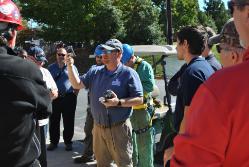Confined Space

Confined Space Entry Program
At Longwood University some of the areas that our employees enter to do maintenance are considered to be confined spaces because their configurations hinder the activities for employees who must enter into, work in and exit from them. In many instances, employees who work in confined spaces also face increased risk of exposure to serious physical injury from hazards such as entrapment, engulfment or hazardous atmospheres. Being in tight quarters itself may pose entrapment hazards, work in confined spaces may keep employees closer to hazards, such as machinery components, than they would otherwise be. In other words, tight quarters, limited access and restricted airflow can result in hazardous conditions that would not normally arise in an open workplace. The term “Permit Required Confined Space” refers to those locations that meet the definition of a confined space and also contain health or safety hazards, thereby requiring a permit for entry.
Longwood University’s Confined Space Program is based on OSHA standard 1910.146 Permit Required Confined Space and the Virginia VAOSHA standard 16VAC25-70-10 et seq Virginia Confined Space Standard For The Telecommunication Industry (1910.268(t)).
The program describes the reasonable and necessary policies and procedures for any and all Longwood University operations that are associated with confined space entry operations.
Individuals’ covered by this program are employees whose job duties involve one or more of the following activities are included:
- Perform actual entries into permit-required confined spaces (Authorized Entrants)
- Serve as an attendant during the permit-required confined space entry (Attendant)
- Supervise others who enter or attend during entries (Entry Supervisor)
The Confined Space Entry Program applies to any Longwood University department that has space(s) that may potentially be hazardous when entered. A confined space is one configured so that a person can fully enter and work, but is not designed for continuous human occupancy and has restricted or limited means of entry or exit.
Examples of confined spaces at Longwood may include, but aren't limited to:
|
|
|
|
|
|
|
|
|
|
|
|
Confined spaces may contain a hazardous atmosphere, engulfment hazards or other hazards, such as electrical, mechanical and fall from a height. These spaces require entry permits that address the hazards, mitigations and required approvals.
Hazards may also be introduced by activities performed inside the space. Use of chemicals, painting, cleaning, grinding or sanding all create atmospheric hazards that can cause injury or illness without adequate ventilation or other controls. Hot work (e.g., welding, cutting, grinding, or brazing) in a confined space may release toxic gases or fumes.
Elements of the Confined Space Entry Program include:
- A written Confined Space Entry program document
- Inventory of permit-required confined spaces and hazards determination
- Development of department-specific confined space entry plans
- Roles and responsibilities for confined space entry supervisors, entrants and attendants
- Confined space signage requirements
- The Longwood University permit system for confined space entry including preparation, use and cancellation of permits
- Methods for hazard mitigation, including air monitoring and use of entry equipment
- Rescue and emergency procedures
- Training of employees
- Contractor requirements
- Audit and inspections of the program
For more information or training scheduling email safety@longwood.edu.
